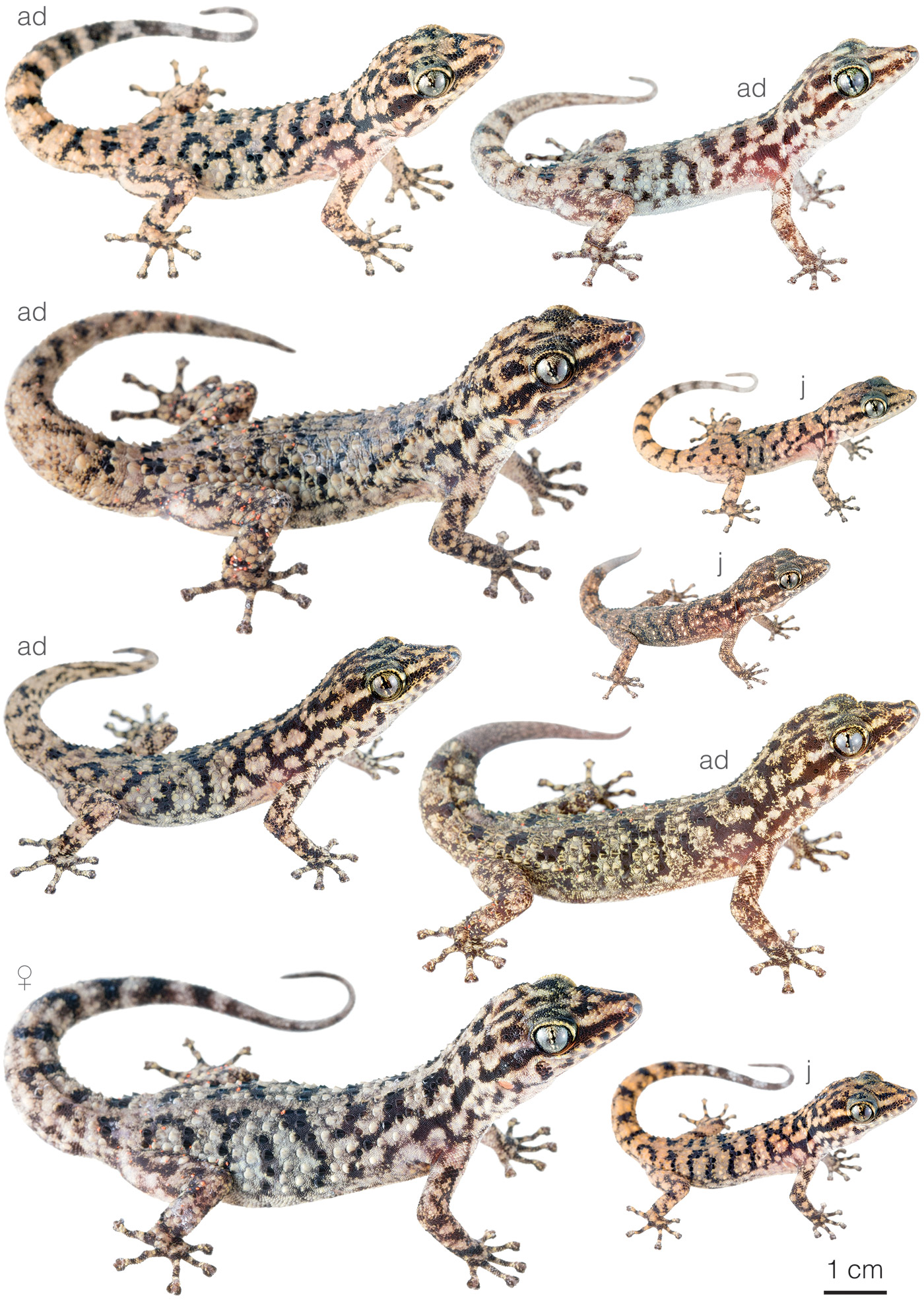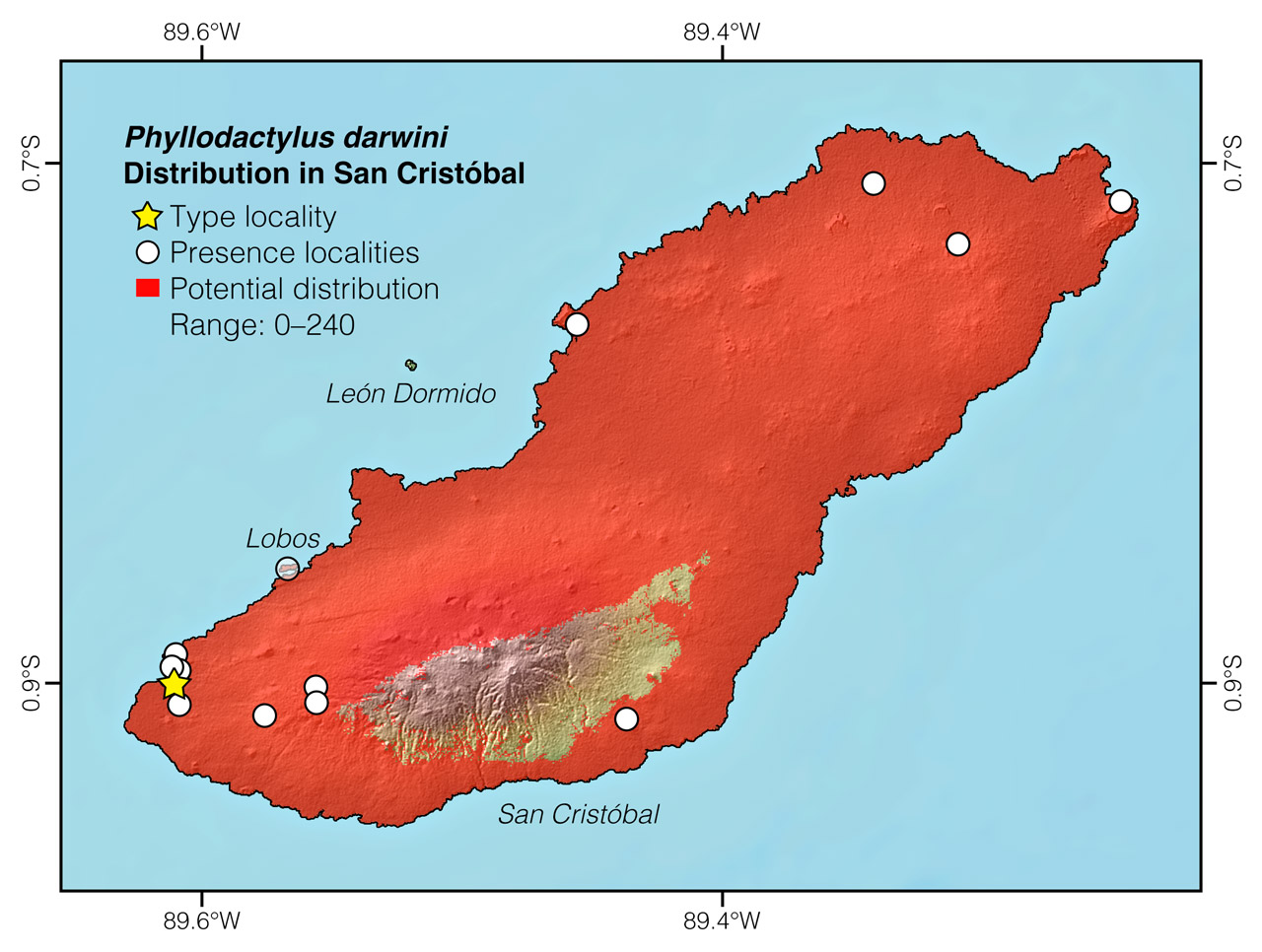Published October 10, 2019. Updated December 22, 2023. Open access. Peer-reviewed. | Purchase book ❯ |
Darwin’s Leaf-toed Gecko (Phyllodactylus darwini)
Reptiles of Ecuador | Sauria | Phyllodactylidae | Phyllodactylus darwini
English common name: Darwin’s Leaf-toed Gecko.
Spanish common names: Geco de Darwin, salamanquesa de Darwin.
Recognition: ♂♂ 12.4 cmMaximum distance from the snout to the tip of the tail. ♀♀ 18.3 cmMaximum distance from the snout to the tip of the tail..1 Geckos in general are easily distinguishable from other lizards by their nocturnal habits and vertical pupils. Phyllodactylus darwini is one of six (two native, four introduced) geckos occurring on San Cristóbal Island. Among these, it is the only one having large protruding scales on both the dorsum and tail (Fig. 1). The most similar co-occurring species is P. reissii, a larger gecko that lacks bulging scales on the tail and is so far restricted to urban and peri-urban areas of San Cristóbal.1

Figure 1: Individuals of Phyllodactylus darwini from Puerto Baquerizo Moreno, Galápagos, Ecuador. j=juvenile.
Natural history: Phyllodactylus darwini is a nocturnal and mostly terrestrial gecko that occurs in moderate densities in dry shrubland areas and, marginally, also in human settlements.1,2 Darwin’s Leaf-toed Geckos forage at ground level or on walls, tree trunks, and rocky outcrops up to 6 m above the ground.1,3 During daytime, they remain hidden under lava blocks, beneath the bark of shrubs, or in crevices.1,2 In most of these microhabitats, this species lives side by side with P. leei.1 The species is probably entirely insectivorous, but so far only crickets4 have been reported as prey items. When threatened, individuals of P. darwini typically flee into crevices. If captured, they are quick to shed the tail. There are recorded instances of predation on this species by housecats.1 The clutch size consists of 1–2 eggs.1
Conservation: Near Threatened Not currently at risk of extinction, but requires some level of management to maintain healthy populations..2 Phyllodactylus darwini is listed in this category because the species is facing the threat of displacement by introduced geckos in areas (currently only urban) where the latter have become invasive,4 as well as predation by housecats, and, therefore, may qualify for a threatened category in the near future if these threats are not addressed. However, there is no current information on the population trend of the Darwin’s Leaf-toed Gecko to determine whether its numbers are declining.1
Distribution: Phyllodactylus darwini is endemic to an area of approximately 496 km2 in San Cristóbal Island and Lobos Islet, Galápagos, Ecuador (Figs 2, 3).

Figure 2: Distribution of Phyllodactylus darwini in Galápagos. See Appendix 1 for a complete list of the presence localities included in the map.

Figure 3: Distribution of Phyllodactylus darwini in San Cristóbal Island. The star corresponds to the type locality: Wreck Bay. See Appendix 1 for a complete list of the presence localities included in the map.
Etymology: The generic name Phyllodactylus comes from the Greek words phyllon (=leaf) and daktylos (=finger),5 and refers to the leaf-shaped fingers characteristic of this group of geckos. The specific epithet darwini honors Charles Darwin.6
See it in the wild: Individuals of Phyllodactylus darwini are considered a guaranteed sighting during any herpetological night hike in the outskirts of Puerto Baquerizo Moreno. The best time to look for the geckos is just after sunset, when they are actively foraging on rocky surfaces.
Authors: Alejandro ArteagaaAffiliation: Fundación Khamai, Reserva Arlequín, Ecoruta Paseo del Quinde km 56, Santa Rosa de Mindo, Pichincha 171202, Ecuador. and Gabriela AguiarbIndependent researcher, Quito, Ecuador.
Academic reviewer: Cruz MárquezcAffiliation: University of Rome Tor Vergata, Rome, Italy.
Photographers: Alejandro ArteagaaAffiliation: Fundación Khamai, Reserva Arlequín, Ecoruta Paseo del Quinde km 56, Santa Rosa de Mindo, Pichincha 171202, Ecuador. and Jose VieiradAffiliation: Tropical Herping (TH), Quito, Ecuador.,eAffiliation: ExSitu, Quito, Ecuador.
How to cite? Arteaga A, Aguiar G (2023) Darwin’s Leaf-toed Gecko (Phyllodactylus darwini). In: Arteaga A, Bustamante L, Vieira J (Eds) Reptiles of Ecuador: Life in the middle of the world. Available from: www.reptilesofecuador.com. DOI: 10.47051/WMUE8310
Literature cited:
- Arteaga A, Bustamante L, Vieira J, Tapia W, Guayasamin JM (2019) Reptiles of the Galápagos: life on the Enchanted Islands. Tropical Herping, Quito, 208 pp. DOI: 10.47051/AQJU7348
- Márquez C, Yánez-Muñoz M, Cisneros-Heredia DF (2020) Phyllodactylus darwini. The IUCN Red List of threatened species. Available from: www.iucnredlist.org. DOI: 10.2305/IUCN.UK.2022-1.RLTS.T48443561A217808624.en
- Olmedo J, Cayot L (1994) Introduced geckos in the towns of Santa Cruz, San Cristóbal and Isabela. Noticias de Galápagos 53: 7–12.
- Photo by Sebastián Ramos.
- Brown RW (1956) Composition of scientific words. Smithsonian Books, Washington, 882 pp.
- Taylor EH (1942) Some geckoes of the genus Phyllodactylus. The University of Kansas Science Bulletin 28: 91–112.
Appendix 1: Locality data used to create the distribution map of Phyllodactylus darwini in Ecuador (Fig. 2). Go to the section on symbols and abbreviations for a list of acronyms used. Asterisk (*) indicates type locality.
| Country | Province | Locality | Source |
| Ecuador | Galápagos | Av. Alsacio | Arteaga et al. 2019 |
| Ecuador | Galápagos | Bahía Sardina, 2 km SE of | iNaturalist; photo examined |
| Ecuador | Galápagos | Cono Media Luna | Arteaga et al. 2019 |
| Ecuador | Galápagos | El Progreso | Arteaga et al. 2019 |
| Ecuador | Galápagos | Finger Point | Arteaga et al. 2019 |
| Ecuador | Galápagos | Galapaguera Cerro Colorado | iNaturalist; photo examined |
| Ecuador | Galápagos | Lobos Islet | iNaturalist; photo examined |
| Ecuador | Galápagos | Mirador Tijeretas | Arteaga et al. 2019 |
| Ecuador | Galápagos | Puerto Baquerizo Moreno | Arteaga et al. 2019 |
| Ecuador | Galápagos | Punta Pitt | Arteaga et al. 2019 |
| Ecuador | Galápagos | Road to the settlement | Arteaga et al. 2019 |
| Ecuador | Galápagos | San Cristóbal | Arteaga et al. 2019 |
| Ecuador | Galápagos | USFQ station | Arteaga et al. 2019 |
| Ecuador | Galápagos | Wreck Bay* | Taylor 1942 |